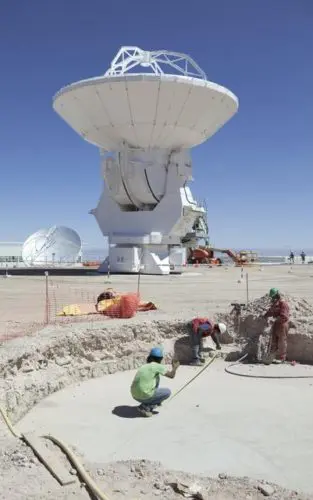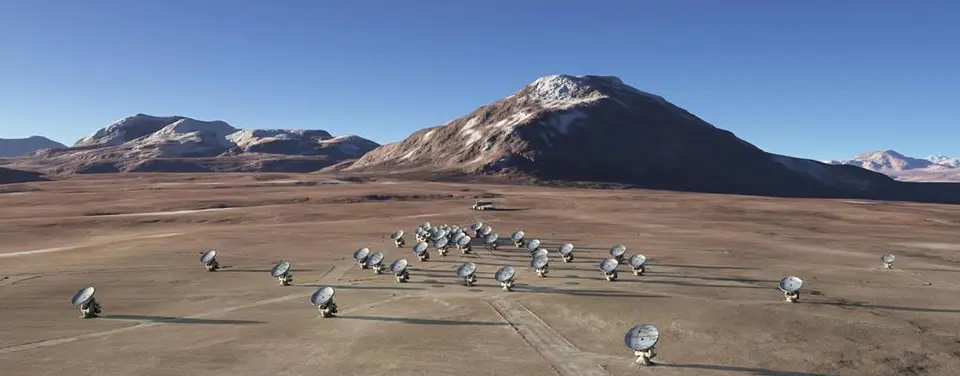Origins
The construction of the observatory dates back to 2004. However, two decades prior to this, the global scientific community had already identified the need for a radiotelescope with the characteristics of ALMA.
The project began when Europe, North America and Eastern Asia each worked in isolation to propose a telescope that would receive light in millimeter and submillimeter wavelengths in large magnitudes.
The National Radio Astronomy Observatory (NRAO) in the United States planned a project called Millimeter Array (MMA), which considered the construction of 40 antennas with 8-meter diameters, reaching an atmospheric window of 30 to 350 GHz to receive millimeter wavelengths.

Operations Support Facility (OSF) - September 2009: In the foreground, workmen are in the process of constructing an additional foundation for an antenna on the terrace in front of the OSF technical building. In the background is one Vertex antenna on the terrace, and another at the lower level, directly in front of the OSF technical building.
© ALMA (ESO/NAOJ/NRAO)
In parallel to this, the European Southern Observatory (ESO) planned the Large Southern Array (LSA), a proposal that considered the installation of 50 antennas with 16-meter diameters, operating with frequencies below 350 GHz and also receiving millimeter wavelengths. Finally, the National Astronomical Observatory of Japan (NAOJ) proposed the construction of a Large Millimeter/Submillimeter Array (LMSA), which considered the same amount of antennas as ESO, but with a 10-meter diameter, and unlike the others, it also planned to receive submillimeter wavelengths.
But it soon became evident that such ambitious projects could not be developed by a single community, and they decided to join forces.
After its design, one of the most important success factors for this type of radioastronomy project lies in its location. Low frequency waves are better received at high altitudes and in dry climates, as this reduces the amount of noise. In addition, the surface area should be large and flat enough for distribution of the antennas. Several areas in New México, Hawaii (Mauna-Kea), France (Plateau de Bure) and northern Africa were explored. However, none of these sites measured up to the conditions in northern Chile, specifically the Chajnantor Plateau , located in the heart of the Atacama Desert.
In 1995, the three partners represented by NRAO, ESO and NAOJ ran tests in the Chilean plains, with positive results. Consequently, in 1999, Europe and North America signed a Memorandum of Understanding, and two years later in Tokyo a resolution was signed to support the joint intent to construct the Atacama Large Millimeter/submillimeter Array (ALMA) between Europe, North America and Japan.
At the end of 2003, after a series of tests, the first stone was placed in what was to become the most ambitious radio observatory on Earth.
